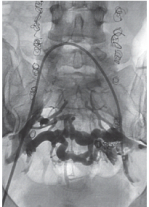
Diagnosis and treatment of pelvic congestion syndrome (PCS)
Thought to pelvic venography be the most accurate method for diagnosis, a venogram is performed by injecting X-ray dye in the veins of the pelvis to make them visible during an X-ray. And MRI may be the best non-invasive way of diagnosing pelvic congestion syndrome. Patients with symptoms can undergo an outpatient procedure known as embolization. A thin catheter is inserted into the femoral vein and guided to the enlarged pelvic veins by X ray guidance. Tiny coils are placed in the enlarged pelvic veins, and a sclerosing agent is injected to seal the vein.


